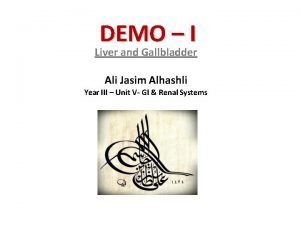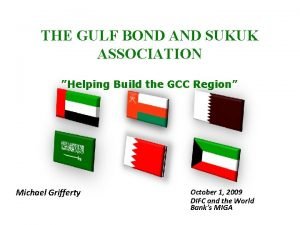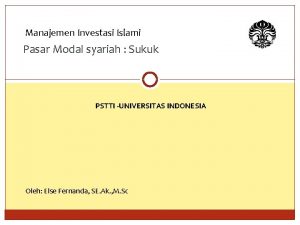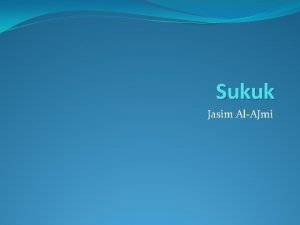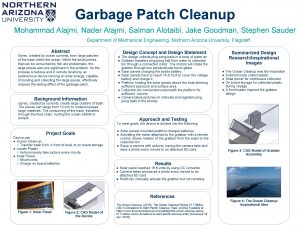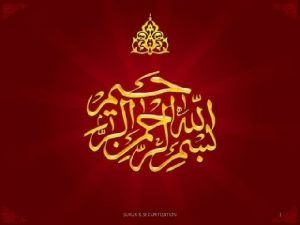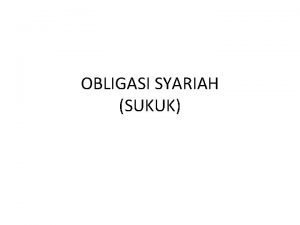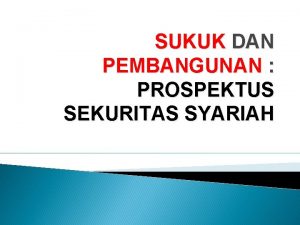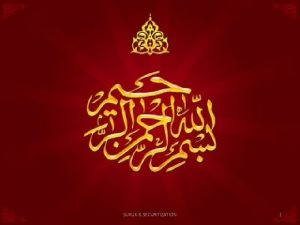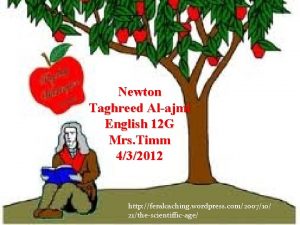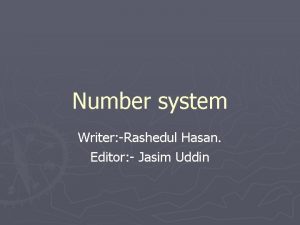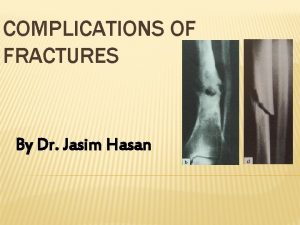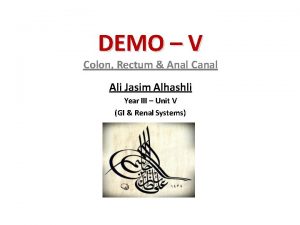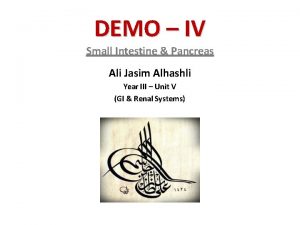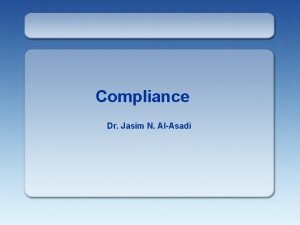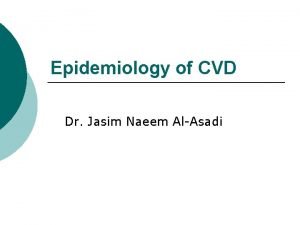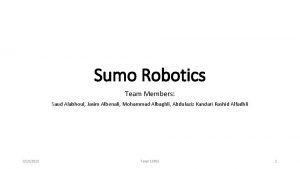Sukuk Jasim AlAJmi What is Sukuk Sukuk is
















































- Slides: 48

Sukuk Jasim Al-AJmi

What is Sukuk? �Sukuk is a certificate evidencing ownership of an asset or its usufruct �The Sukuk structures rely on the creation of a Special Purpose Vehicle (SPV) �SPV would issue Sukuk certificates which represent either ownership of an asset, entitlement to a debt or to rental incomes or even accumulation of returns from various Sukuk (a hybrid Sukuk) �The return provided to a Sukuk holders come in the form of profit from a sale, rental or combination of both

How Sukuk is created? �Sukuk is created via ‘securitisation’ process i. e. a process of converting something into cash or equivalent in the form of papers that are tradable in the secondary market �“The process of packaging financial promises and transforming them into a form whereby they can be freely transferred among the multitude of investors” (Davidson, Andrew, et. al. in Securitization : Structuring and Investment Analysis)

Securitization Involves: �Evaluating specific risks �Isolating and efficiently allocating risks �Evaluating the taxation, accounting and legal implications within the regulatory framework �Designing appropriate credit enhancement structures e. g. over collateral, cash collateral, subordination etc. �Pricing the residual risk.

Historical Background - Sukuk � Need for liquidity and good liquidity management � Different periods between maturities of assets and deposits – resulting in either surplus of non performing cash or a shortage of cash to fund investments � Lack of: – active interbank and secondary market (mostly primary market trading) – acceptable Sharia’a compliant instruments – acceptable regulatory conditions – limited available agency credit ratings – unsophisticated market – limited information flow The need for a more sophisticated capital, financial and insurance market.

Modern Application Sukuk represent an undivided beneficial ownership of, and the return generated from, an underlying asset � The Accounting and Auditing Organisation for Islamic Finance Institutions (“AAOIFI”) Sharia’a standard 17 (Investment Sukuk) definition: certificates of equal value put to use as common shares and rights in tangible assets, usufructs and services; or equity in a project or investment activity � Sukuk must be carefully distinguished from equity notes and bonds �

Use of Sukuks by Sovereign and Corporate �Balance sheet management �Provides the ability to monetise a broad universe of existing Islamic financial activities �Attracts global investors – very beneficial for emerging markets �Provides a method to achieve long term financing �Provides an attractive capital market exit �Secondary market tradability �A tool to manage liquidity in a credit crunch �A method to attract ethical investors who are seeking to: - invest in socially responsible activities; or - make a constructive contribution to an emerging market

Use of Sukuks by Sovereign and Corporate �Additional considerations for a sovereign issuer are: - unlocking new sovereign markets - an alternative to raising taxes - funding project and infrastructure development - promoting jurisdictions as a regional/global financial centre (e. g. London, Hong Kong, Nairobi) - demonstrating its commitment to Islamic Finance

How do Sukuk differ from Conventional Bonds Asset Considerations Asset-based transaction Asset-backed transaction q The Sukuk is not secured on the underlying asset, and it receives an irrevocable third-party guarantee q Sukuk is secured on the asset, with recourse to the Issuer / third party of the transaction q The Guarantor / Issuer commits to cover all payments due in case of non payment q Alternatively, it can resembling an ABS in a securitisation with no recourse to a third party q The credit risk depends on the creditworthiness of the Guarantor q The credit risks on the Sukuk is to some extent based on the performance of the underlying assets , its value, and its ability of to generate sufficient cash to meet all payments q The Sukuk will rank pari-passu with all the Guarantor / Issuer’s obligations with similar seniority / subordination In case of event of default § The Issuer / Guarantor will be obliged to buy back the Sukuks at par value § The Sukukholders will not have the right to claim back the assets or to use or lease the Sukuk assets to any other third party § There only option is to claim to the guarantor the exercise price under the purchase undertaking agreement In case of event of default § Inventors enforce their security, effectively taking immediate procession of the Sukuk assets § The Sukukholders will have the right to use, sell or lease the Sukuk assets to any other third party § If investors have recourse to the Issuer / Guarantor, the issuer will be liable to pay any outstanding balance not covered by the value of the Sukuk assets § In case of non-recourse, investors will only be entitled to the Sukuk assets

Comparing Sukuk with Bonds � Sukuk do not represent issuer debt, but represent an undivided ownership share in the specific assets/projects/services � Asset backed/Asset based � A minimum of 51% tangible assets � Claims � sukuk holders have ownership claims on the specific underlying assets/projects/services � Security � secured by ownership rights in the underlying assets or projects in addition to any other structured collateral enhancement mechanisms

Comparing Sukuk with Bonds � Principal and return � not guaranteed by the issuer � Purpose � must only be issued for purposes permitted by Islam (halal) � Tradability � sale of ownership interest in a specific asset/project/service � Responsibility of holders � sukuk holders have responsibility for defined duties relating to the underlying assets/projects/transactions limited to the extent of participation of the issue � Use of proceeds � sukuk proceeds must be hypothecated and earmarked for a specific use. This is an essential tool to achieve proximity of assets to sukuk holders.

Uses of Sukuk Funds � Project-specific Sukuk � Under this category money is raised through Sukuk for specific project. For example, Qatar Global Sukuk issued by the Government of Qatar in 2003 to mobilize resources for the construction of Hamad Medical City (HMC) in Doha. In this case a joint venture special purpose vehicle (SPV), the Qatar Global Sukuk QSC, was incorporated in Qatar with limited liability. This SPV acquired the ownership of land parcel, that was registered in the name of HMC. The land parcel was placed in trust and Ijarabased Trust Certificates (TCs) were issued worth US$700 million due by October 2010. The annual floating rate of return was agreed at LIBOR plus 45 basis points. � Assets-specific Sukuk � Under this arrangement, the resources are mobilize by selling the beneficiary right of the assets to the investors. For example, the Government of Malaysia raised US$ 600 million through Ijara Sukuk Trust Certificates (TCs) in 2002. Under this arrangement, the beneficiary right of the land parcels has been sold by the government of Malaysia to an SPV, which was then re-sold to investors for five years. The SPV kept the beneficiary rights of the properties in trust and issued floating rate Sukuk to investors. � Another example of Asset-specific Sukuk is US$250 million five-year Ijara Sukuk issued to fund the extension of the airport in Bahrain. In this case the underlying asset was the airport land sold to an SPV. � Balance Sheet-specific Sukuk � An example of the balance sheet specific use of Sukuk funds is the Islamic Development Bank (IDB) Sukuk issued in August 2003. The IDB mobilized these funds to finance various projects of the member countries. The IDB made its debut resource mobilization from the international capital market by issuing US$ 400 million five-year Sukuk matured in 2008.

Types of Sukuk �Ijara �Mudarabah �Musharakah �Murabahah �Salam �Istisna’ �Muzara’a (sharecropping)/ Musaqa (irrigation) �Mugharasa (agricultural) �Hybrid

Sukuk Al Ijara

Islamic Sukuk-Sukuk Al Ijarah § Ijarah is an Islamic alternate of conventional leasing. § Issuing certificates of ownership of assets, leased to a particular customer is known as Sukuk Al Ijarah or simply Ijarah Sukuk. § Ijarah Sukuk concept is one of the most popular concepts among issuers of global Islamic Sukuk. § A simple process is explained next.

Islamic Sukuk-Sukuk Al Ijara § If a Company requires, for example, $50 million for the purchase of land, real asset, equipment etc it can issue Ijara sukuk equalling that amount in small denominations, say $50, 000 each. § After collection of funds from the investors the company either purchases the asset on behalf of the Sukuk investors or transfers the ownership of the already acquired asset to sukuk holders usually by establishing a Special Purpose Vehicle (SPV), which owns the underlying assets.

Islamic Sukuk-Sukuk Al Ijara § The investor or sukuk holders owns the asset held by SPV as Trustee in the form of Sukuk. The asset is then leased to the firm and the lease proceeds from the asset is distributed to the sukuk holders as return/dividend. § The returns on the sukuk certificates could be either fixed or floating. As the expected returns (predetermined rental payments) are fixed and can be treated as predictable like the coupon payments of a conventional bond.

Islamic Sukuk-Sukuk Al Ijara sukuk can be issued through a financial intermediary, a bank or a brokerage house or directly by the users of the lease asset. A third party can also guarantee rental payments. Since the yield is predetermined and the underlying assets are not liquid but tangible and secured, thus the Ijarah certificate can be freely traded in the secondary markets at par, premium or discount.

Sukuk Al Ijara Periodic distributions and redemption proceeds Originator Transfer the ownership Purchase Price SPV Issuer/Lessor SPV leases the assets SPV Issues Sukuk Subscription Proceeds Rents and Exercise price Lessee/Customer Investors/Sukuk holders

Investment Banking Products Direct Structuring of Sukuk – Al-Ijara SPV collects funds from investors 3 Investment Bank 1 Company seeks advice from Investment Bank regarding issue; an SPV is created for the purpose; Company as agent of SPV takes delivery of Assets; Company 5 SPV issues securities to investors; SPV 6 Company takes Assets from SPV on Ijara and makes payment of Ijara rentals to SPV; Asset(s) Direct Structuring of Sukuk – Al-Ijara 4 SPV pays to Vendor for purchase of Assets; Vendor 2 Sukuk Investors 7 SPV passes them on to investors after deducting Mudarib share/wakala fee for itself

Ijara – based Securitization Investment Bank SPV receives payments by company in future; 4 Company seeks advice from Investment Bank regarding securitization; assets are identified and pooled together; Company creates SPV; sells existing assets to SPV 1 2 Asset(s) Company SPV/SPE 5 SPV pays to Company the sale price of Assets Sukuk 3 SPV issues securities to investors against these assets 6 Company buys back Assets on deferred payment basis 7 SPV receives payments by company in future 8 SPV passes on payments by company to investors after deducting Mudarib share Investors

Islamic Sukuk-Sukuk Al Ijara § Important Conditions § Ijarah Sukuk represents the holder's proportionate ownership in the leased asset. § The holder will assume the rights and obligations of the owner/lessor to the extent of his ownership. § As owner the holder will have the right to enjoy a part of the rent according to his proportion of ownership in the asset. § In the case of total destruction of the asset, holder will suffer the loss to the extent of his ownership. § SPV rules in in some countries does not allow SPV to hold actual tangible assets, therefore, the asset is shown on the books of the client itself instead of SPV.

Islamic Sukuk-Sukuk Al Ijarah Essential Condition “It’s essential that the Ijarah Sukuk are designed to represent real ownership of the leased assets, and not only a right to receive rent. ”

Islamic Sukuk-Sukuk Al Ijara �Diminishing Musharakah structure is used to develop Sukuk There are two basic differences in Diminishing Musharakah Sukuk: Underlying Assets is jointly owned by investors and issuer according to specified percentage. Ownership is also transferred periodically to the issuer. Ijarah is essential part of a Diminshing Musharakah transaction under Shirkatul Milk.

Murabaha Sukuk

Investment Banking Products Direct Structuring of Sukuk-Al - Murabaha SPV collects funds from investors; Investment Bank 1 Company seeks advice from Investment Bank regarding issue; an SPV is created for the purpose; Company as agent of SPV takes delivery of Assets; Company 5 3 6 SPV issues securities to investors; SPV Company purchases Assets from SPV on 4 deferred payment basis and makes payment of installments to SPV; SPV pays to Vendor for purchase of Assets; Asset(s) Vendor 2 Sukuk Investors 7 SPV passes them on to investors after deducting Mudarib share/wakala fee for itself

Investment Banking Products Murabaha-based Securitization SPV collects funds from investors; 4 Investment Bank Company seeks advice form Investment Bank regarding 1 securitization; assets are identified and pooled together; Asset(s) SPV issues securities to investors against these assets; 2 Company creates SPV; sells existing assets to SPV 3 SPV Sukuk Investors 5 SPV pays to Company the sale price of Assets; 6 Company buys back Assets on deferred payment basis; 7 SPV receives payments by company in future; 8 SPV passes on payments by company to investors after deducting Mudarib share

Sukuk Al Salam

Islamic Sukuk-Sukuk Al Salam § Salam is an Islamic mode of finance. Under a Salam transaction the seller makes an advance payment for goods which are to be delivered later provided the goods are defined and the date of delivery is fixed § It is not permissible to trade in Salam Sukuk during the term of the Sukuk since the underlying asset is a debt created through advance payment of the sale price. § Risk before delivery of the product(s) § Credit § Liquidity § Market (price risk), if the holders of did not issue a parallel salam contract

Salam Sukuk Structure Distributions of Profit Buyer in the Parallel Salam Sale Price Sale of the asset SPV/agent Purchase price SPV Issues Sukuk Subscription Proceeds Goods/Products Issuer/Seller Investors/Sukuk holders

Salam Sukuk § Government of Bahrain first issued Salam Sukuk as an alternate to short term government treasury bill. § Under the transaction Government took an advance payment from the investors for a future delivery of Aluminium ingots. A paper was issued as an acknowledgment of receipt which is known as Salam Sukuk. § Upon delivery of Aluminium ingots to the investors at the time of completion of Salam contract, Government sold ingots to third parties as agent of the investors. § The difference between Sale and Purchase price was the profit of the investors.

Sukuk Al Musharakah

Islamic Sukuk-Sukuk Al Musharakah is a mode of financing against which Sukuk can be issued. If a company required financing for any of its project through Musharakah it can issue Sukuk against which investors would provide funding as per the rules of Musharakah. Every Sukuk would represent holder's proportionate ownership in the assets of the Musharakah. Once the majority of the cash amount is converted into fixed assets, these Musharakah Sukuk can be treated as negotiable instruments in the secondary market.

Islamic Sukuk-Sukuk Al Musharakah �Important conditions § Profit earned by the Musharakah is shared according to an agreed ratio between the Issuer and Investors at an agreed ratio. § Loss is shared on pro rata basis. § Profit & Loss is shared between the investors as per investment ratio only. § To ensure tradability of the Sukuk following condition should be adhered to: All the assets of the Musharakah should not be in liquid form. At least 20% of the value of Portfolio should be invested in nonliquid assets.

Islamic Sukuk-Sukuk Al Musharakah Sukuk can be used for number of purposes including: Construction of Projects and factories Expansion Projects Working Capital Finance Sitara's Musharakah's TFC advised and arranged by Meezan Bank Ltd. is an excellent example of a Musharakah Sukuk.

Sukuk Al Musharaka Periodic distributions And redemption proceeds SPV Issues Sukuk Subscription Proceeds SPV Issuer/Lessor Capital contribution Partner Contribution In kind Share of profits and losses Lessee/Customer Share of profits and losses Manage Investors/Sukuk holders Invest Lessee/Customer

The Investment Dar US$100 Million Musharaka Sukuk � Issuer: � The Investment Dar Sukuk Company (B. S. C), a Bahraini Shareholding Company incorporated in Bahrain and owned by ABC Islamic Bank (E. C. ) � Arab Banking Corporation (B. S. C. ). � Sukuk Type � Musharaka Partners � TID and Issuer � Each Musharaka Partner’s entitlement to the Musharaka Assets will be undivided ownership of the Musharaka Assets. � Management Agent: � The Investment Dar (TID) � Obligor: � TID � Musharaka Assets: � All tangible and intangible assets of Musharaka, including all assets acquired after, from or through the application of the capital contribution.

Sukuk Structure 1. Issuer Enters into a Musharaka Agreement with TID. 2. Issuer Contributes 49% of capital in cash while TID will contribute 51% of the capital in kind - in the form of vehicles, which will be valued at their actual value. Total capital of Musharaka: $ 390, 802, 000. Issuer’s contribution: $ 100, 000. TID’s Contribution: $ 290, 801, 000 (11, 903 new and used vehicles) 3. Purpose of the Musharaka will be to earn profit from the application of capital contributions in accordance with the Musharaka business plan. 4. Profits will be distributed among the partners in proportion to their respective capital contributions.

Sukuk Structure (Cont) TID will undertake management of the Musharaka under a separate management agreement. If the issuer’s profit share is in excess of agreed amount, the surplus distributable profit shall be paid to the management agent as incentive fee. 6. Units of Musharaka will be sold under decline Musharaka concept to TID such that entire Musharaka units are ultimately owned by TID. 7. TID will execute a purchase undertaking in favor of the Issuer, in which it undertakes, following the giving of an exercise notice by the issuer, to purchase 10% of the initial amount of the issuer’s units at exercise price on each periodic distribution date or on the occurrence of an dissolution event. 5.

Overview of Structure periodic distribution amounts Purchase undertaking SUKUK Sukuk proceeds Management agreement ISSUER TID Sukuk proceeds vehicles Profit distribution MUSHARAKA lease/purchase payments The Investment Dar US$100 Million Musharaka Sukuk Lease/sale of vehicles/equipment LESSEES/ PURCHASERS

Islamic Sukuk-Standardization AAOIFI has issue Sharia’a standards for Sukuk and its expected that issuance of these standards would help reducing differences in fatwas issued for Sukuk.

Sharia’a Compliance & Market Conditions � Recent developments � December 2007 - Sheikh Usmani letter � 14 February 2008 – AAOIFI Sharia'a pronouncement, clarifying that: � � � Sukuk, to be tradable, must be owned by the sukuk holders with all the rights and obligations of ownership of real assets The Manager of sukuk issuances must certify the real transfer of such assets It is not permissible to agree to purchase assets from sukuk holders for a nominal value �It is permissible to agree to purchase assets at net value, market value • Sharia’a-compliant credit support is still permissible • Consequences of the pronouncement

Islamic Sukuk-Criticism § Some Sukuk are criticized for their close resembelence with conventional bonds. § Many times these closeness is created to adhere to the tax and other regulatory laws of the country. § For example, in Pakistan SPVs cannot hold actual assets. For this reason assets cannot be carved out from the balance sheet of the issuer which creates complexities in identification of the assets and only a hypothecation charge ensures bank's beneficial ownership in the Musharakah assets.

Islamic Sukuk-Criticism Similarly, concept of the Diminishing Musharakah financing is not there in the stamp duty laws of Pakistan, which compels banks to sell share in assets without any legal registration. It should be noted that concept of Diminishing Musharakah is recognized in British stamp duty laws since April 2003. Nevertheless, not all of this criticism is incorrect, and therefore it should be ensured that unnecessary usage of artificial structures should be avoided as much as possible.

Islamic Sukuk-Criticism The problems could be resolved by Sharia'a rating systems. This will help investors in making informed decisions regarding the authenticity of the Sharia'a structure of the Sukuk.

Benefits § Sukuk can be used very effectively as a halal alternate to conventional bonds for providing funding for matching maturities and without relying too much on commercial banking sector. § Another aspect of Sukuk which make them more effective than bonds is there ability to mobilize and motivate investors to work for the overall benefit of the issuer. § Sukuk are priced competitively in line with conventional bond issues § Sukuk are Shariah-compliant investments § Sukuk generally have better risk profile § Sukuk are tradable and fill the existing need for Shariah compatible tradable instruments § Short Term Islamic Financial Market can benefit from Sukuk

Type Features Tradebility Murabahah Sakk represents assets purchased & intended for sale. Once sale is made, the sakk represents a debt. In M’sia – this is short term debt security Sukuk are only tradable under Malaysian rules Ijarah Sakk must lay title claim to asset. The claim may be direct or beneficial. Sukuk are universally tradable Musharakah Sakk must lay title claim to asset, but this may include participation in business ownership or operations. Frequently, an undertaking is added to make musharakah operation more debt like. Depending on the underlying asset, these Sukuk are tradable. In M’sia, the underlying asset may be a permissible debt form such as a murabahah receivable. BBA Sakk represents assets purchased and intended for sale. Once the sale is made, the sakk represents a debt. In M’sia – this is a long term debt security Sukuk are only tradable under Malaysian rules. Wakalah Sukuk holders appoint the beneficiary of funds as their agent to perform certain business operations. Depending on the underlying asset, these Sukuk are tradable. In M’sia, the underlying asset may be a permissible debt form such as a murabahah receivable.

Islamic Structures Istina’a Structure q The Istisna’a contract specifically relates to construction and manufacturing (the asset to Issuer be financed not being in existence) q Under this agreement, Investors fund the work Istisna’a Sale or construction in progress, and undertake to Price + mark-up at Agreement 2 produce the asset according to agreed completion specifications at a determined price and fixed date of delivery q Investors then sell the asset to the Issuer at the manufacturing price plus a reasonable profit Investors q Full payment does not need to be made in advance and can be deferred q The fixed price charged to the Issuer by the Pay Istisna’a Sale Delivers asset 1 financier cannot be changed merely to reflect production Agreement produced factors that affect the time value of money costs q The Istisna’a transaction can be done in conjunction with an Ijara transaction, so that Contractor once the asset is complete it can be leased back to the Issuer (may be Issuer) Fixed income-like product most applicable to assets to develop / construct and is usually used in conjunction with an Ijarah
